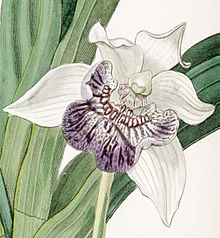| Cochleanthes | |
|---|---|
 | |
| Cochleanthes flabelliformis | |
| Scientific classification | |
| Kingdom: | Plantae |
| Clade: | Tracheophytes |
| Clade: | Angiosperms |
| Clade: | Monocots |
| Order: | Asparagales |
| Family: | Orchidaceae |
| Subfamily: | Epidendroideae |
| Tribe: | Cymbidieae |
| Subtribe: | Zygopetalinae |
| Genus: | Cochleanthes Raf. |
| Type species | |
| Cochleanthes fragrans (syn of C. flabelliformis) | |
The genus Cochleanthes is made up of 4 species of orchids native to Mexico, Central America, the West Indies and South America. [1] The name Cochleanthes refers to the shape of the flower (in Greek, cochlos means "shell" and anthos means "flower").[ citation needed ]